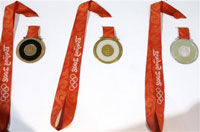China hands 3,000 Olympic medals over to organizers
The gold, silver and bronze medals that will hang around the necks of winning athletes at next month's Olympics were formally handed over Thursday to the organizers of the Beijing games.

The 3,000 medals made for the Olympics and a similar number for the Paralympics were delivered by BHP Billiton, an Olympic sponsor and the world's largest mining company, during an hour-long ceremony near Tiananmen Square.
"We're fully prepared for the Beijing Games. All the preparations are now in place," said Jiang Xiaoyu, executive vice president of the Beijing Olympics organizing committee.
BHP Billiton China President Clinton Dines said the company decided to become a major Olympic sponsor because it wanted to show its commitment to the host nation.
"China is very important to us. It's 20 percent of our global business," he said during an interview with reporters. "This is a big moment for China as a nation."
A total of 1,000 medals for each category was made - enough for all the winning athletes, including those in group sports, to receive a medal. Another 3,000 medals for the Paralympics, which will be held in September, were also turned over to Beijing's Olympics Organizing Committee. Another 51,000 commemorative medals were also made.
The Melbourne-based company said the metals were shipped from its mines in Chile and Australia - more than 28 1/2 pounds (13 kilograms) of gold, 2,954 pounds (1,340 kilograms) of silver, and 15,278 pounds (6,930 kilograms) of copper. The medals, which incorporate jade from Qinghai province, were made in China.
The gold medals are actually made of silver with a gold plating. The commemorative medals were made from copper, explaining the large total amount of copper required.
Olympian Gao Min, who won gold medals in diving at the 1988 and 1992 games, praised the medals for being more beautiful than previous ones.
"It is the dream of all athletes to win a medal at the Games," she said. "My Olympic medals represent the biggest honor of my lifetime and I cherish them."
These Olympics marked the first time the medals - with the jade inlay - were designed in a public competition.
The winning entry by China's Central Academy of Fine Arts has a distinctive Chinese style with an embossed double-dragon design, a ring of jade inlay and a gold rim. Gold and jade signify virtues of honor and ethics while the dragon connotes strength.
Subscribe to Pravda.Ru Telegram channel, Facebook, RSS!

